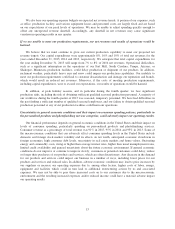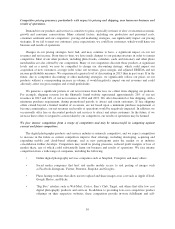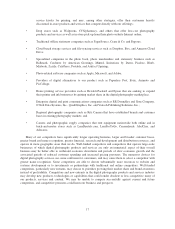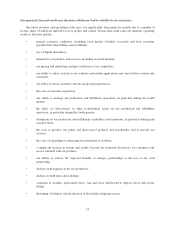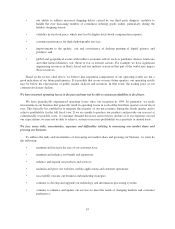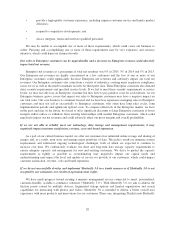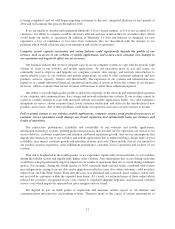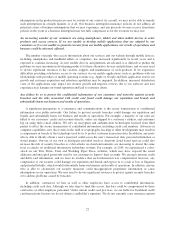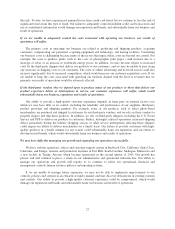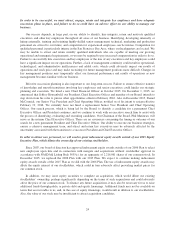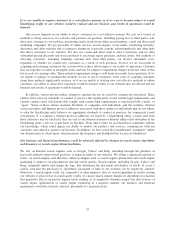Shutterfly 2015 Annual Report Download - page 27
Download and view the complete annual report
Please find page 27 of the 2015 Shutterfly annual report below. You can navigate through the pages in the report by either clicking on the pages listed below, or by using the keyword search tool below to find specific information within the annual report.If we are unable to acquire customers in a cost-effective manner, or if we were to become subject to e-mail
blacklisting, traffic to our websites would be reduced and our business and results of operations would be
harmed.
Our success depends on our ability to attract customers in a cost-effective manner. We rely on a variety of
methods to bring visitors to our websites and promote our products, including paying fees to third parties who
drive new customers to our websites, purchasing search results from online search engines, e-mail and direct mail
marketing campaigns. We pay providers of online services, search engines, social media, advertising networks,
directories and other websites and e-commerce businesses to provide content, advertising/media and other links
that direct customers to our websites. We also use e-mail and direct mail to attract customers, and we offer
substantial pricing discounts and or free products to encourage repeat purchases and trial orders. Our methods of
attracting customers, including acquiring customer lists from third parties can involve substantial costs,
regardless of whether we acquire new customers as a result of such purchases. Even if we are successful in
acquiring and retaining customers, the cost involved in these efforts impacts our results of operations. Customer
lists are typically recorded as intangible assets and may be subject to impairment charges if the fair value of that
list exceeds its carrying value. These potential impairment charges could harm our results from operations. If we
are unable to enhance or maintain the methods we use to reach consumers, if the costs of acquiring customers
using these methods significantly increase, or if we are unable to develop new cost-effective methods to obtain
customers, our ability to attract new customers would be harmed, traffic to our websites may be reduced and our
business and results of operations would be harmed.
In addition, various private entities attempt to regulate the use of e-mail for commercial solicitation. These
entities often advocate standards of conduct or practice that significantly exceed current legal requirements and
classify certain e-mail solicitations that comply with current legal requirements as unsolicited bulk e-mails, or
“spam.” Some of these entities maintain blacklists of companies and individuals, and the websites, Internet
service providers and Internet protocol addresses associated with those entities or individuals that do not adhere
to what the blacklisting entity believes are appropriate standards of conduct or practices for commercial e-mail
solicitations. If a company’s Internet protocol addresses are listed by a blacklisting entity, e-mails sent from
those addresses may be blocked if they are sent to any Internet domain or Internet address that subscribes to the
blacklisting entity’s service or purchases its blacklist. From time to time we are blacklisted, sometimes without
our knowledge, which could impair our ability to market our products and services, communicate with our
customers and otherwise operate our business. In addition, we have noted that unauthorized “spammers” utilize
our domain name to solicit spam, which increases the frequency and likelihood that we may be blacklisted.
Our business and financial performance could be adversely affected by changes in search engine algorithms
and dynamics, or search engine disintermediation.
We rely on Internet search engines such as Google, Yahoo! and Bing, including through the purchase of
keywords related to photo-based products, to generate traffic to our websites. We obtain a significant amount of
traffic via search engines and, therefore, utilize techniques such as search engine optimization and search engine
marketing to improve our placement in relevant search queries. Search engines, including Google, Yahoo! and
Bing, frequently update and change the logic that determines the placement and display of results of a user’s
search, such that the purchased or algorithmic placement of links to our websites can be negatively affected.
Moreover, a search engine could, for competitive or other purposes, alter its search algorithms or results causing
our websites to place lower in search query results. If a major search engine changes its algorithms in a manner
that negatively affects our paid or unpaid search ranking, or if competitive dynamics impact the effectiveness of
search engine optimization or search engine marketing in a negative manner, our business and financial
performance would be adversely affected, potentially to a material extent.
25


